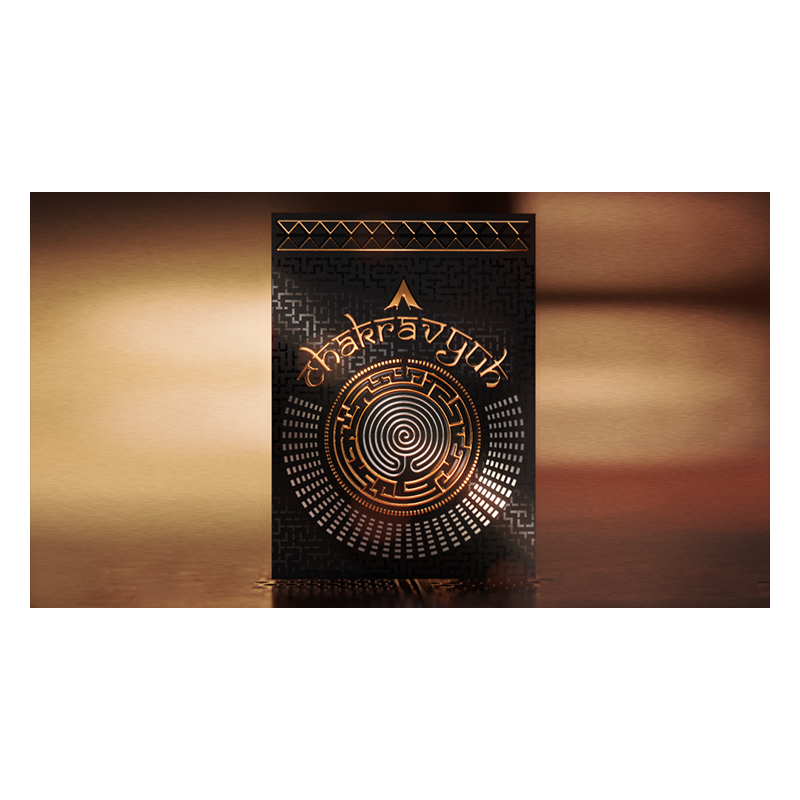- On sale -5%






Features of the tuck case:Premium black high-gsm card stock with soft touch finish tuck caseReddish Gold, matte silver, and black foiled Embossed designsProduced by Legends Playing Cards Co.Features of the playing cards:Premium Legends classic finish
Features of the tuck case:
Features of the playing cards:
In the great ancient Indian epic, the Mahabharata, two royal bloodlines, the Pandavas and the Kauravas fight against each other for the throne of Hastinapura, in the battle of Kurukshetra.
The Pandavas, led by the five righteous brothers, are formidable warriors, and with the divine lord Krishna by their side, they are poised to win the war. However, the Kauravas, are also masterful soldiers, and are proving a great challenge in the battle.
On the thirteenth day of the great fight, the Kauravas deployed the impenetrable formation, the Chakravyuh, to defend their flanks.
The Chakravyuh, a fluidic labyrinthine strategy, comprising of seven readjusting concentric spiral tiers of soldiers, designed to completely entrap its victim, was deployed to squash the Pandavas. Only a handful of warriors from the Pandava side knew how to penetrate the Chakravyuh, namely, Abhimanyu, Arjuna, Krishna and Pradyumna. However, on the day of the battle only Abhimanyu was present and he led the charge to penetrate this formation.
Abhimanyu, the son of Arjuna, received the knowledge of how to enter the formation whilst in his mother's womb, as his maternal uncle, lord Krishna, was narrating the strategy to his pregnant sister Subhadra. However, Subhadra not finding the topic interesting fell asleep halfway, cutting the description of the strategy short. This small moment in his infancy would change the fate of Abhimanyu forever on the battlefield, as he was to face the armies of the Kauravas.
Trying to defend the Pandavas, Abhimanyu fought hard, and reached the sixth tier of the formation, and was attacked simultaneously by the mighty Kaurava commanders, an act against rules of righteous warfare. Here the small moment from his infancy would come back to haunt him, as he knew only how to enter the labyrinthine walls, not how to escape it. Facing an unwinnable battle, the Kauravas slowly exhausted Abhimanyu, with an incessant barrage of attacks, and finally killed the great warrior.
The Chakravyuh is a military strategic formation described in the Indian epic, the Mahabharata, deployed by the Kauravas to entrap the heroes of the tale, the Pandavas.
The brief story of the Chakravyuh in the epic, is included across the campaign page in segments, please read them to get a fuller understanding of the history that inspired this deck.
The triple foiled tuck box is inspired by the symbolism of the Mahabharata as well, as the vast canon of great Indian mythos and philosophy.
The playing cards themselves are themed around the concept of mazes, with each number card making up an individual and unique puzzle for you to enjoy for hours.
The Tuck Box
The design of the tuck box is inspired by the symbolism of the Mahabharata, as well as the vast canon of great Indian mythos and philosophy.
The central object of the tuck box, the Chakravyuh is foiled in matte silver. The seven tiers individually embossed create a wave like pattern against your fingers as you feel the details of the deck.
The outer shell, also a labyrinth, symbolizes the greater war that exists beyond the spiralling walls of the Chakravyuh. But there is an escape route, being directed by the large arrow, a compass on your way towards liberation.
The tuck box also has a running black foiled maze pattern, that enhances the look and detail of the deck. It makes the design continuous, though the six sides are unique.
The Back
The Back is based on the description of the universe as per the ancient scriptures of India.
There are 3 components to the design. The bottom pyramid, encompassing the spiritual eye
The central portion, on the top of the pyramid with 3 symbols making up the Hindu trinity, and finally the rays stretching out to the sides.
The three symbols that is central to the back design is Hindu trinity of Lord Brahma, the creator, symbolized by the lotus; the 3 horizontal lines signifying Lord Shiva, the destroyer; and the 3 vertical lines symbolizing Lord Vishnu the preserver, who holds the dynamic between creation and destruction of the cosmos.
They are central to the design as they are from which all the dynamics of the universe emanated and is being maintained.
The bottom half holds a pyramid which symbolizes the illusory world of Maya, with the spiritual eye in the middle. It is said through meditation you can see beyond this world and transcendent it to the planes beyond, primarily the astral and the causal.
After you escape the two-fold world of material and astral, there is the causal world which is signified by the large circular maze surrounding the 3 trinities at the centre.
When you go beyond the causal you reach the realm of liberation and you are no longer bound to suffering and this is signified by the rays at the edge of the design.
The top design is based on another maze design in the hexagonal pattern giving it a more unique look. The whole design is foiled and embossed giving it a more intriguing three-dimensional render.
The left side of the deck has a line from third chapter of the ancient Indian text, the Svetasvatara Upanishad, it says, "na anya pantha vidyate" or "The wise there is no other way." Which means that There is no other means for the embodied being to attain supreme peace besides this. It also falls in line with the t